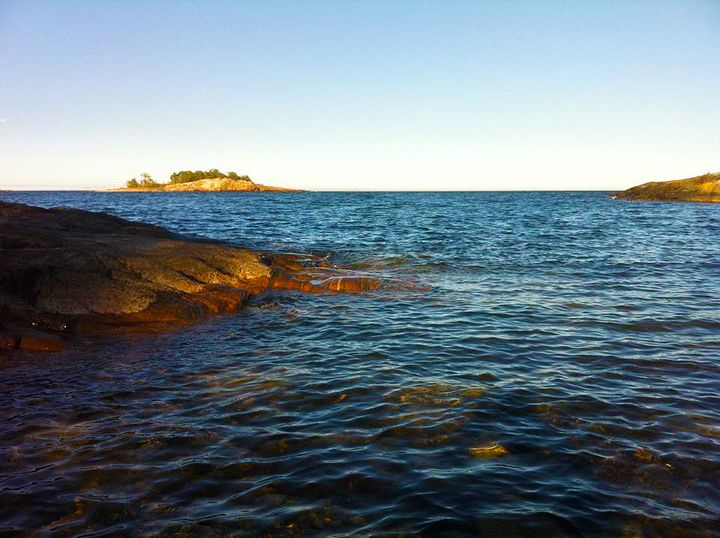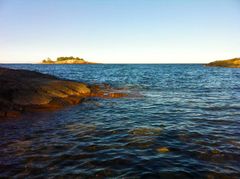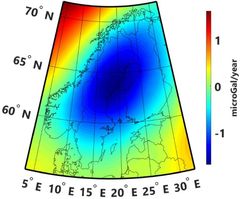As Scandinavian peninsula rises from sea, new satellite data shows gravity changes
Bouncing back from under the weight of Ice Age glaciers which have long since vanished, the Nordic region land mass is slowly rising above sea level. Two scientists at Sweden’s KTH Royal Institute of Technology have a refined a method for measuring and predicting the small details of how this slow movement changes Earth’s gravitational pull over time. One thing they found is that the Fennoscandinavian peninsula's land mass is more dense than previously known.

For decades, KTH researchers Mohammad Bagherbandi and Lars Sjöberg have been examining what’s informally known as the post-glacial rebound effect in Fennoscandinavia, a peninsula that includes Sweden, Norway, Finland and part of Russia. Their latest study reports a refined measurement method that combines remote sensing by satellite and terrestrial gravity data, as well as 3D positioning from GPS and similar satellite positioning systems.
The KTH researchers found that the density of the upper mantle is about 3,546 kilograms per cubic meter—slightly more than reported in earlier studies. It is widely believed the land mass rises by as much as 1 cm per year.
Bagherbandi, a research her in geodesy and land surveying at KTH, says the new technique highlights the value of satellite data in the field of geodesy, the science of accurately measuring and understanding the Earth's geometric shape, orientation in space, and gravity field
“Beginning 60 years ago, scientists were using terrestrial gravimeters to establish gravity reference system and study temporal changes in gravity associated with glacial isostatic adjustment (GIA),” Bagherbandi says. “Our study is an alternative technique to study this phenomenon."
This means researchers can now create alternative and comparable models of how the land and gravity are changing over time in the region, he says.
“This discovery helps us understand the slow ‘bounce-back’ of land after the Ice Age,” Bagherbandi says. “It also shows how important the Global Geodetic Observing System (GGOS) are for learning about Earth’s movements and gravity changes.”
A similar study is underway in the U.S., where scientists are evaluating an even larger region of North America that is known to be rising.
Bagherbandi says understanding these changes is valuable beyond the field of geodesy. It helps scientists improve their tools for studying Earth's geodynamics. It can also help with other fields, like preparing for rising sea levels and learning about natural disasters.
Read the scientific article:
Bagherbandi, M., Sjöberg, L.E. A short note on GIA related surface gravity versus height changes in Fennoscandia. Journal of Geodesy
Images


Subscribe to releases from KTH Royal Institute of Technology
Subscribe to all the latest releases from KTH Royal Institute of Technology by registering your e-mail address below. You can unsubscribe at any time.
Latest releases from KTH Royal Institute of Technology
For graphene production, a potential green alternative to mining graphite3.3.2025 14:14:40 CET | Press Release
Researchers in Sweden report a green alternative to reduce reliance on mining graphite, the raw source behind the "wonder material" graphene.
AI on aircraft can help prevent stalls and terrifying drops in altitude17.2.2025 15:58:14 CET | Press Release
Artificial intelligence could help prevent terrifying mid-air drops in altitude. In a new study, an international research team successfully tested a machine learning system for preventing trouble with turbulence.
Alternative to studded winter tires reduces airborne particles by 20 percent6.2.2025 14:41:07 CET | Press Release
On icy roads, studded winter tires can save lives – but they pulverize pavement and fill the air with dangerous, inhalable particles. A new Swedish study shows that both road wear and airborne particles could be reduced by as much as 20 percent if studs were made instead with an alternative hard metal.
Study on ship sliming may enable reduced costs and emissions in ocean transport21.1.2025 11:25:01 CET | Press Release
Slime build-up is a costly drag on fuel efficiency for ocean-going cargo ships, leading to more emissions and, eventually, higher consumer prices. A recent study, however, suggests a new approach to managing this common problem.
To compete globally, Europe’s seafood farmers may get boost from AI research14.11.2024 13:30:27 CET | News
Underwater drones adapted to cold Nordic waters, and sensors that listen to the sounds of fish eating. These are some of the AI solutions that could give European sea farmers a boost to compete globally. Researcher Fredrik Gröndahl explains how maching learning is being developed take on operational challenges and reduce costs in aquaculture, particularly in inaccessible waters far offshore.
In our pressroom you can read all our latest releases, find our press contacts, images, documents and other relevant information about us.
Visit our pressroom